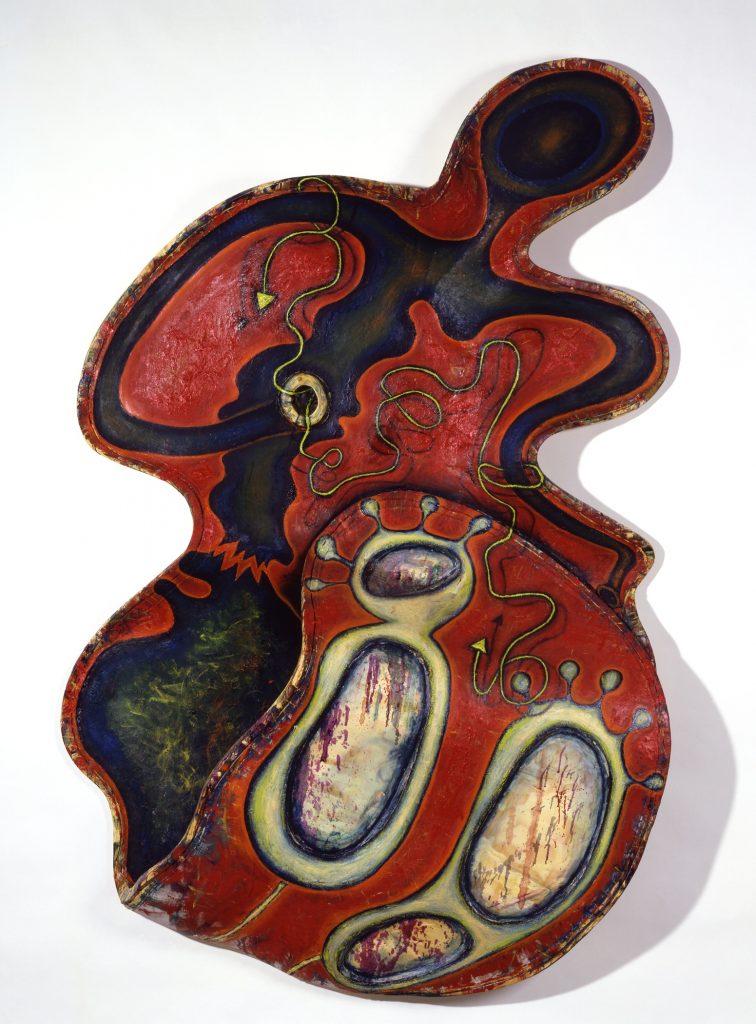Pigeon (work of art)
Artwork Info
Key Ideas
- This abstract oil painting was inspired by surrealist painter Salvador Dalí’s famous melting clocks and the form of a woman’s body. These elements are represented in this painting by the hands of a clock and the outline of a humanlike figure.
- Elizabeth Murray was an American postmodern abstract artist. She was also considered a neo-expressionist artist.
- Murray is best known for her shaped canvas paintings that use bright, bold colors and sculptural elements. Her artistic style was influenced by her lifelong interest in cartoons and comic books.
- The title of this work is a reference to the pigeons that lived in the artist’s studio.
Learn More
American artist Elizabeth Murray considered her paintings a form of storytelling. Her work often began as a shape that she sketched or molded in clay. She then created her paintings on laminated wood and canvas. Murray is best known for creating large paintings on three-dimensional, shaped canvases that look like sculptures.
Starting to make a painting is like starting to tell a story.
Elizabeth Murray
Murray was an abstract painter. The style of her work has elements of both postmodernism and neo-expressionism. Postmodern art mixes different art styles and mediums. Neo-expressionist art depicts recognizable objects, uses vibrant colors, and often includes figures that are distorted and look like cartoons. Many of Murray’s paintings blur the lines between painting and sculpture. They also combine elements of representational and abstract art. Representational art depicts some aspect of reality, and abstract art does not attempt to represent reality.
Pigeon is named for the birds that lived in Murray’s art studio, which was located in a barn. This painting’s shape was inspired by the melting clocks motif that was made famous by surrealist painter Salvador Dalí. Murray’s painting incorporates the blue-green outline of a woman’s figure within a form that resembles a melting clock. The hands of a clock also appear in two places, at the ends of yellow lines that twist and turn throughout the composition. The figure’s oversized shoes or footprints appear on the upturned flap at the bottom edge of the canvas. As Murray developed this painting, the form of the woman disappeared. The outline of the figure’s dress, torn at the waist, is all that remains of her.
My paintings are often strange, and sometimes show me a part of myself – a violence and physicality that scares me. It’s not always pleasant or easy. I don’t always like it, and really when I do them it’s a journey.
Elizabeth Murray
From an early age, Murray was fascinated with cartoons, comic books, and animation. As a child she drew her own cartoons. She even wrote a letter to Walt Disney and offered to be his secretary. Other influences on Murray’s art include the work of artists Joan Miró, Paul Cézanne, and Frank Stella.
All my ideas about art came from looking at comic books.
Elizabeth Murray
tags: Surrealism, change, identity, movement, play, variation, artist’s process, narrative
Additional Resources
Resources for Teachers
- Read an interview with Elizabeth Murray.
- Watch a video of Murray responding to a question about the shoe imagery in many of her paintings.
- Visit a web page to find out more about neo-expressionist art and artists.
Resources for Students
- Watch a video of Murray painting a shaped canvas.
- View additional artworks by Murray.
- Watch a video about the melting clocks in Salvador Dalí’s paintings.
Images
-

Pigeon
An abstract painting on an irregularly shaped, three-dimensional canvas. The main paint colors are bold blue, green, red, and yellow tones. The work includes the blue-green outline of a humanlike figure and the hands of a clock. Shapes resembling footprints are featured on the upturned, rounded edge at the bottom of the painting.
